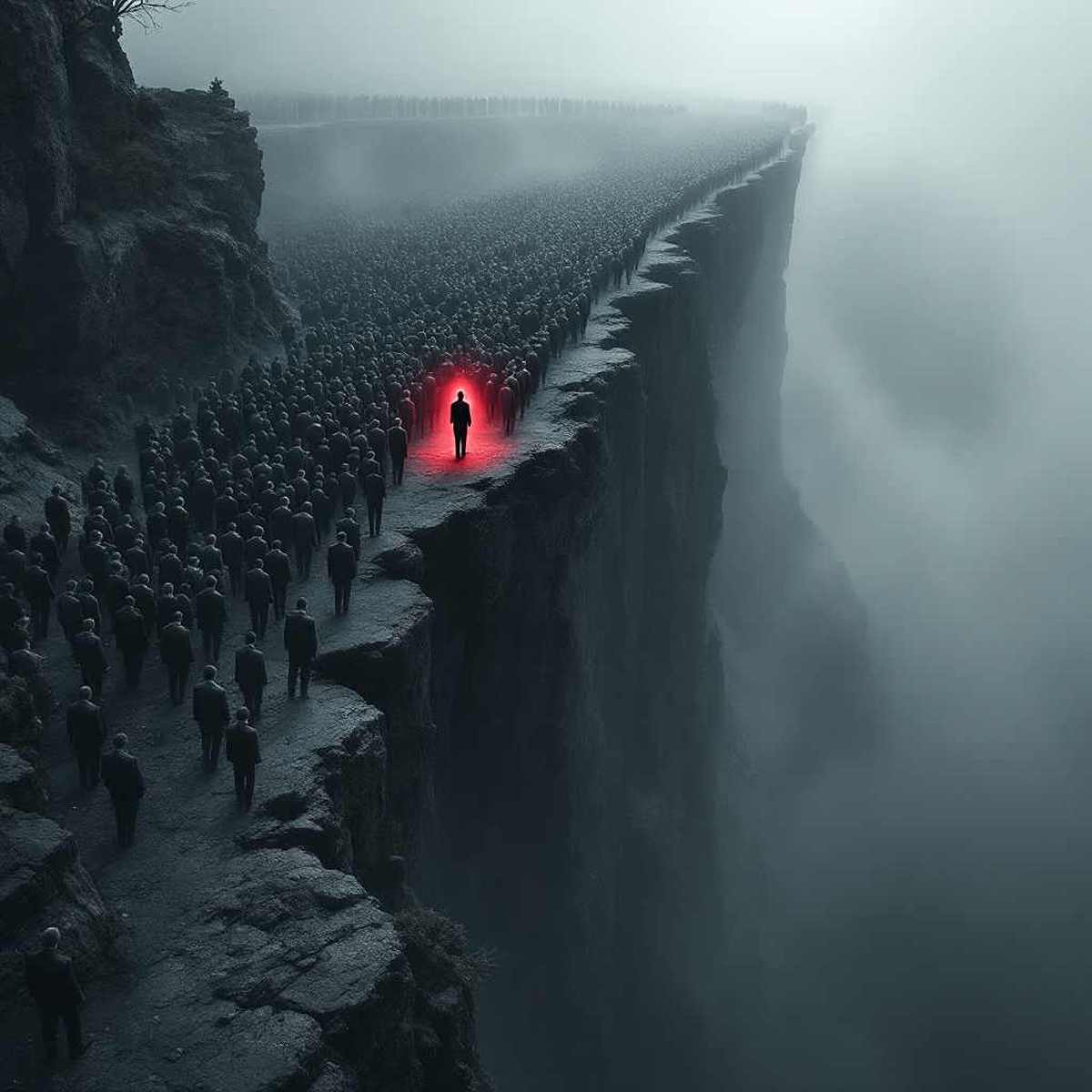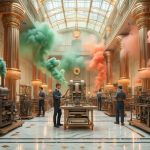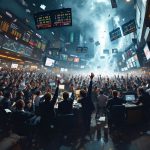Stock Market Bottom: Fools Try Time Tem: the Wise Position Quietly
May 22, 2025
Introduction: Stock Market Bottom– The Glow Always Comes Too Late
There’s a kind of madness that grips certain hikers at dusk.
They claw their way up the ridge—sweating, triumphant. But once they hit the summit, their eyes aren’t soaking in the view. They’re scanning, hunting, calculating angles like the last photon is a trade they can’t afford to miss.
Cameras up, ISO dialled, feet fidgeting like traders before a Fed announcement, breath held hostage, everything riding on the final flicker.
And it always slips past.
The glow doesn’t crest where they thought. Clouds smear the light. The horizon cheats. The tree line eats the moment. And just like that, it’s gone.
But they linger—paralysed—as if stillness might bend time backwards, as if reverence could make the glow return.
It never does.
Because sunsets don’t close with a bang, they evaporate.
And chasing the last moment means you miss every other one. Like markets, you don’t know it was the bottom until it’s already behind you.
The Lure of the Perfect Exit
No one talks about the walk back down.
After all that strain and stillness—after the obsession with timing perfection—there’s just the crunch of boots on loose gravel. No cheers. No flash. Just cold air and an empty trail.
The camera’s dead. The light’s gone. And the glow you wanted? It was never meant to stay.
But here’s the kicker: they missed everything real while chasing that mythical climax. The cooling breeze before the dip. The gold that lit up the boulders five minutes too early. The birds whispering their last notes into dusk.
They missed the moment by worshipping the ending.
That’s what markets do to people, too.
The pursuit of the perfect exit warps your lens. Turns you into a ghost—hovering over possibility, unable to act or feel. You don’t exit clean. You bleed out slowly.
And by the time you want to move, the story has already ended without you.
The truth?
The moment you try to script a flawless ending, you start losing everything that made it worth beginning.
Flinch, Freeze, Fall
Investors do this too.
They stand at the edge of a market bottom, desperate to time the flicker. Not to understand it. Not to move with it. To catch the mythical last tick before reversal. The exact low.
They chart. They screen. They scroll for confirmation bias in twelve flavours.
And when the market does finally turn… they hesitate. They flinch. What if this isn’t the real glow? What if there’s another dip? What if—what if—what if—
And the bottom… becomes the past.
Not because it was hard to see. But because they couldn’t move without guarantees.
Like hikers who won’t take a step until the colour hits just right.
By the time they believe it’s safe, the trail is empty. The price has already climbed. The breath they were holding turns into a sigh, then silence.
They’re Not Wrong, Just Miswired
Let’s pause here.
These people aren’t dumb. They’re precise, analytical, and often deeply thoughtful. But they’ve confused precision with control. They think the perfect entry is an earned reward for patience. That if they wait long enough, they’ll be given certainty.
But bottoms aren’t awarded. They aren’t certified. They’re psychological breaking points—murky, volatile, invisible until they pass.
What’s maddening is that bottoms don’t feel like opportunities. They feel like failure, like risk compounding, like maybe it never comes back.
That’s why the real inflexion points are almost always obvious after. In real time, they feel like jumping off a cliff blindfolded.
The market knows this, and it feeds on it. The longer you hesitate, the more it runs.
Dead Air, Then Roar
Look back at 1932. Nobody rang a bell. The bottom came with a whisper, not a bang. The Dow had bled nearly 90% from its highs. Breadlines stretched for blocks. Industrial production had collapsed by half. Banks weren’t just failing—they were vanishing, overnight, taking life savings with them. Roosevelt wasn’t even in office yet. There was no policy rescue, no coordinated bailout—just dust, desperation, and silence.
Who had the gall to buy when everything smelled like death?
Or March 2009. The S&P was haemorrhaging, down over 50%. General Motors teetered on extinction. Lehman was already a tombstone. AIG, Citigroup, and Fannie Mae were zombie institutions kept upright with duct tape and denial. CNBC became a funeral home. Bank of America was trading under $4. The VIX read like a scream.
Then, without ceremony, the market turned.
Not because confidence returned. It didn’t.
But because despair had maxed out. Sellers were exhausted. Even the pessimists ran out of ammo.
The same happened in March 2020: COVID lockdowns. ICU footage looped like horror cinema. Oil collapsed below zero, negative pricing. Airports were deserted. The Nasdaq shed hundreds of points by the hour. Companies yanked guidance. Corporate debt markets froze. The Fed panicked. Treasury yields evaporated. You could almost hear the collective gasp of investors clutching cash like it was oxygen.
And yet again, in the middle of a global psychosis, the floor hardened.
Why?
Because the selling climaxed, because the panic hit a saturation point, and fear had nowhere else to go but silence.
This pattern repeats: not in form, but in sensation.
1974: stagflation, Watergate, oil embargo. The bottom arrived in October like a thief at dawn.
1987: a 22% single-day crash. But within days, the tape stabilised, even as headlines stayed apocalyptic.
2002: the dot-com burial. Enron, WorldCom, 9/11 aftermath. But by late ’02, the market began crawling upward while the narrative still wheezed with disbelief.
Every major bottom is shrouded in dead air—a vacuum. No celebrations. No parades. Just the absence of more bad.
Then something shifts—not loud, not clean—a trickle of buying, a few higher lows, a fade in volatility.
And that’s the tell: not hope, not reason—momentum’s reappearance in a desert of disbelief.
No indicator blinks green. No guru confirms it.
Just price… shifting weight. Tentatively. Then defiantly.
Because markets don’t wait for you to feel safe.
They move when you feel nothing.
When Silence Is the Tell
Here’s the uncomfortable truth: the bottom never feels like a bottom. It feels like betrayal.
The news is still negative. Analysts are still downgrading. Social sentiment is radioactive. Everything looks wrong.
But the tape… starts acting different.
There’s volume without news. Panic selling slows. Low-beta names twitch green. The silence becomes textured. Not relief—tension. The kind you feel in a theatre before the lead takes the stage.
And if you wait for permission? You miss it.
That’s the nature of bottoms. They’re stealth moves. They punish hesitancy and reward discomfort.
The Last Buyer, The First Ghost
Chasing the exact low? That’s performance art like sipping the last drop of coffee without tilting the mug—delusion disguised as discipline.
Everyone wants max gain, zero drawdown, no bruises.
But the one who buys the bottom never knows it’s the bottom.
They move anyway.
Not reckless—ruthless.
They scale in small. They eat heat. They get cut and stay standing.
Because survival isn’t clean—it’s calculated bleeding.
You don’t catch a bottom.
You endure it.
You drown slowly until the pressure turns familiar, and price turns irrational.
And when the signal’s finally clear?
So is the alpha. Gone. Priced out. Ghosted.
Why You Don’t Feel Ready
Because you’re human, and humans aren’t built to buy bottoms.
Your brain’s a trauma machine—built to flinch, not charge.
Every crash, every flash, every loss—it etches fear into your neural firmware.
So when the market screams, your instinct begs: “Wait. Just a little longer.”
But obvious is death.
By the time it feels safe, the trade’s already been stolen.
The best entries feel like mistakes.
The worst ones feel like genius.
So you wait.
One more dip. One more flush. One more candle to whisper reassurance.
And the market?
It leaves you. It doesn’t argue. It just… moves.
It Was Never the Glow That Mattered
Back on the ridge.
No fanfare. No noise. Just you, the wind, and a path narrowing with every step.
The light you chased? Gone.
But so is the crowd.
And what’s left… is clarity.
Maybe the victory was never in catching the sun.
Maybe it was knowing when to stop chasing—before the light became a myth you couldn’t stop worshipping.
You didn’t miss it.
You outgrew it.
Insights That Matter













